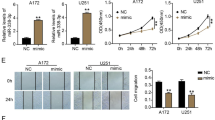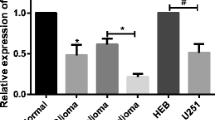Abstract
Objective
To explore the molecular mechanism of microRNA-599(miR-599) in the migration and invasion of glioma.
Result
Clinicopathological characteristics of 33 patients were analyzed. Based on reverse transcription-PCR, miR-599 was down-regulated in glioma tissues compared with adjacent normal brain tissues (P < 0.001). Moreover, negative correlations between miR-599 and periostin protein expression in glioma tissues (P < 0.01) and necrosis by magnetic resonance imaging (P < 0.05) were observed. Transwell and wound healing assays showed that overexpression of miR-599 inhibited glioma cell migration and invasion. miR-599 down-regulated periostin expression by targeting the 3′-untranslated region. Additionally, re-expression of periostin partial reversed the suppressive effect of miR-599 on migration and invasion in vitro and in vivo.
Conclusion
microRNA-599 inhibits proliferation and invasion by down-regulating periostin expression in vitro and in vivo.





Similar content being viewed by others
Change history
12 September 2023
This article has been retracted. Please see the Retraction Notice for more detail: https://doi.org/10.1007/s10529-023-03435-2
References
Baril P, Gangeswaran R, Mahon PC, Caulee K, Kocher HM, Harada T, Zhu M, Kalthoff H, Crnogorac-Jurcevic T, Lemoine NR (2007) Periostin promotes invasiveness and resistance of pancreatic cancer cells to hypoxia-induced cell death: role of the beta4 integrin and the PI3k pathway. Oncogene 14:2082–2094
Bartel DP (2009) MicroRNAs: target recognition and regulatory functions. Cell 2:215–233
Conway SJ, Izuhara K, Kudo Y, Litvin J, Markwald R, Ouyang G, Arron JR, Holweg CT, Kudo A (2014) The role of periostin in tissue remodeling across health and disease. Cell Mol Life Sci 7:1279–1288
Fu Y, Zheng S, Rui H, An N, Zheng Y, Zhang Z, Liang A (2012) A potential strategy for high-grade gliomas: combination treatment with lithium chloride and Bm K CT. Biotechnol Lett 1:9–17
Gillan L, Matei D, Fishman DA, Gerbin CS, Karlan BY, Chang DD (2002) Periostin secreted by epithelial ovarian carcinoma is a ligand for alpha(V)beta(3) and alpha (V) beta (5) integrins and promotes cell motility. Cancer Res 18:5358–5364
Huo F, Chen Z, Hong H, Wang Y (2016) MicroRNA-144-3p inhibits proliferation and induces apoptosis of human salivary adenoid carcinoma cells via targeting of mTOR. Biotechnol Lett 3:1–8
Louis DN, Perry A, Reifenberger G, von Deimling A, Figarella-Branger D, Cavenee WK, Ohgaki H, Wiestler OD, Kleihues P, Ellison DW (2016) The 2016 World Health Organization classification of tumors of the central nervous system: a summary. Acta Neuropathol 6:803–820
Mohammadian A, Mowla SJ, Elahi E, Tavallaei M, Nourani MR, Liang Y (2013) Normalization of miRNA qPCR high-throughput data: a comparison of methods. Biotechnol Lett 6:843–851
Murakami Y, Tanahashi T, Okada R, Toyoda H, Kumada T, Enomoto M, Tamori A, Kawada N, Taguchi YH, Azuma T (2014) Comparison of hepatocellular carcinoma miRNA expression profiling as evaluated by next generation sequencing and microarray. PLoS ONE 9:e106310–e106314
Otaegui D, Baranzini SE, Armañanzas R, Calvo B (2009) Differential Micro RNA expression in PBMC from multiple sclerosis patients. PLoS ONE 7:e6309
Tian B, Zhang Y, Zhang J (2014) Periostin is a new potential prognostic biomarker for glioma. Tumour Biol 6:5877–5883
Tian J, Hu X, Gao W, Zhang J, Chen M, Zhang X, Ma J, Yuan H (2016) Identification a novel tumor-suppressive hsa-miR-599 regulates cells proliferation, migration and invasion by targeting oncogenic MYC in hepatocellular carcinoma. Am J Transl Res 6:2575–2584
Wang H, Wang Y, Jiang C (2013) Stromal protein periostin identified as a progression associated and prognostic biomarker in glioma via inducing an invasive and proliferative phenotype. Int J Oncol 5:1716–1724
Wojcicka A, Piekielko-Witkowska A, Kedzierska H, Rybicka B, Poplawski P, Boguslawska J, Master A, Nauman A (2014) Epigenetic regulation of thyroid hormone receptor beta in renal cancer. PLoS ONE 5:e97610–e97624
Xiao ZM, Wang XY, Wang AM (2015) Periostin induces chemoresistance in colon cancer cells through activation of the PI3K/Akt/survivin pathway. Biotechnol Appl Biochem 3:401–406
Supplementary information
Supplementary Table 1—Primer sequences used.
Author information
Authors and Affiliations
Corresponding author
Electronic supplementary material
Below is the link to the electronic supplementary material.
About this article
Cite this article
Zhang, T., Ma, G., Zhang, Y. et al. RETRACTED ARTICLE: miR-599 inhibits proliferation and invasion of glioma by targeting periostin. Biotechnol Lett 39, 1325–1333 (2017). https://doi.org/10.1007/s10529-017-2365-7
Received:
Accepted:
Published:
Issue Date:
DOI: https://doi.org/10.1007/s10529-017-2365-7




